 Honda Accord: DLC Circuit Troubleshooting
Honda Accord: DLC Circuit Troubleshooting
NOTE: If you suspect the HDS or the HDS DLC cable may be the source of the communication probrem, verify that they are working properly by connecting them to a known-good, like vehicle and system, and checking for a communication preblem.
1. Turn the ignition switch to LOCK (0).
2. Connect the HDS to the DLC (see page 11-3).
NOTE: Make sure the HDS is properly connected to the DLC.
3. Turn the ignition switch to ON (II), and read the HDS.
Does the HDS identify the vehicle? YES
-Go to step 4.
NO
-Go to step 21.
4. Check for Pending or Confirmed DTCs in the PGM-FI system with the HDS.
Are any Pending or Confirmed DTCs indicated? YES
-Go to the indicated DTCs troubleshooting.
NO-
- If the HDS does not communicate with the SRS, go to step 5.
- If the HDS does not communicate with the VSA system, go to step 7.
- If the HDS does not communicate with the TPMS, go to step 9.
- If the HDS does not communicate with the IMMOBI (immobilizer) system, go to step 11.
- If the HDS does not communicate with the BODY ELECTRICAL system, go to step 13.
5. Turn the ignition switch to LOCK (0).
6. Turn the ignition switch to ON (II), and watch the SRS indicator.
Does the SRS indicator come on and go off?
YES
-Go to step 15.
NO-
Go to the SRS general troubleshooting information (see page 24-36).
7. Turn the ignition switch to LOCK (0).
8. Turn the ignition switch to ON (II), and watch the VSA indicator.
Does the VSA indicator come on and go off? YES
-Go to step 15.
NO-
Go to the VSA system symptom troubleshooting for ABS indicator, brake system indicator, VSA indicator do not go off (see page 19-129).
9. Turn the ignition switch to LOCK (0).
10. Turn the ignition switch to ON (II), and watch the TPMS indicator.
Does the TPMS indicator come on and go off? YES
-Go to step 15.
NO
-Go to the TPMS symptom troubleshooting for TPMS indicator does not go off, and no DTCs are stored (see page 18-80).
11. Turn the ignition switch to LOCK (0).
12. Turn the ignition switch to ON (II), and watch the immobilizer indicator.
Does the immobilizer indicator stay on or flash? YES
-Go to the immobilizer system's troubleshooting (see page 22-429).
NO-
Go to step 15.
13. Do the gauge self-diagnostic function (see page 22-332).
14. Check the gauge display.
Is Error 2 indicated? YES
-Check for B-CAN system DTCs (see page 22-109).
NO
-Go to step 15.
15. Turn the ignition switch to LOCK (0), then do the battery terminal disconnection precedure (see page 22-91), and wait at least 3 minutes before starting work.
16. Disconnect the HDS from the DLC.
17. Check for continuity between DLC terminal No. 7 and body ground.
DATA LINK CONNECTOR (DLC)
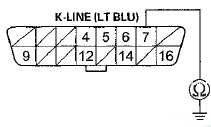
Terminal side of female terminals
Is there continuity? YES
-Go to step 18.
NO
-Go to step 19.
18. Continue to check for continuity between DLC terminal No. 7 and body ground while disconnecting these connectors, one at a time:
- SRS unit connector A (39P)
- VSA modulator-control unit 36P connector
- TPMS control unit 20P connector
- Immobilizer-keyless control unit 7P connector
- Audio unit connector A (24P)
- Driver's under-dash fuse/relay box connector Q (20P)
Does continuity go away when one of the above connectors is disconnected? YES-
Replace the part that caused an open when it was disconnected.
NO
-Repair short in the wire between the DLC (K-line) and the VSA modulator-control unit, the SRS unit, the TPMS control unit, the immobilizer-keyless control unit, the audio unit, or the driver's under-dash fuse/relay box.
19. Connect DLC terminal No. 7 to body ground with a jumper wire.
DATA LINK CONNECTOR (DLC)
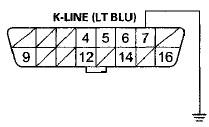
Terminal side of female terminals
20. Check for continuity between body ground and these connector terminals:
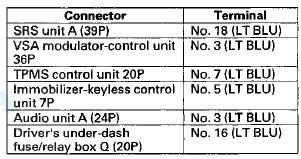
Is there continuity between body ground and each of the terminals in the chart? YES-
Replace the part that does not communicate with the HDS.
NO
-Repair open in the wire between the DLC (K-line) and the appropriate connector
21. Check for B-CAN system DTCs without the HDS (see page 22-138).
Is DTC U0029 and/or U0100 indicated? YES-
Go to step 32.
NO
-Go to step 22.
22. Turn the ignition switch to LOCK (0).
23. Disconnect the HDS from the DLC.
24. Measure the voltage between DLC terminal No. 16 and body ground.
DATA LINK CONNECTOR (DLC)
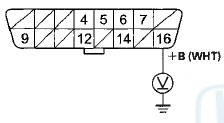
Terminal side of female terminals
Is there battery voltage? YES
-Go to step 25.
NO
-Repair open in the wire between DLC terminal No. 16 and the No. 15 BACK UP (10 A) fuse in the under-hood fuse/relay box.
25. Measure the voltage between DLC terminals No. 4 and No. 16.
DATA LINK CONNECTOR (DLC)

Terminal side of female terminals
Is there battery voltage? YES
-Go to step 26.
NO
-Repair open in the wire between DLC terminal No. 4 and body ground (G502) (see page 22-34).
26. Connect the HDS to the DLC (see page 11-3).
27. Jump the SCS line with the HDS.
28. Disconnect ECM/PCM connector A (49P).
29. Disconnect the HDS from the DLC.
30. Check for continuity between ECM/PCM connector terminal A3 and DLC terminal No.6.
DATA LINK CONNECTOR (DLC)
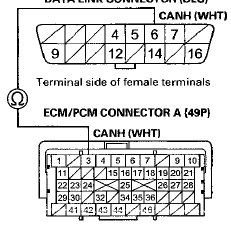
Terminal side of female terminals
Is there continuity? YES
-Go to step 31.
NO
-Repair open in the wire between the ECM/PCM (A3) and DLC terminal No. 6.
31. Check for continuity between ECM/PCM connector terminal A4 and DLC termilal No.14.
DATA LINK CONNECTOR (DLC)
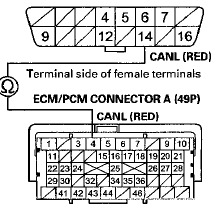
Terminal side of female terminals
Is there continuity? YES
-Update the ECM/PCM if it does not have the latest software (see page 11-203), or substitute a known-good ECM/PCM (see page 11-7), then recheck.
If the symptom/indication goes away and the ECM/PCM was updated, troubleshooting is complete.
If the symptom/indication goes away and the ECM/PCM was substituted, replace the original ECM/PCM (see page 11-204).
NO
-Repair open in the wire between the ECM/PCM (A4) and DLC terminal No. 14.
32. Try to start the engine.
Does the engine start and idle smoothly? YES
-Go to the F-CAN circuit troubleshooting (see page11-172).
NO
-Go to step 33.
33. Turn the ignition switch to LOCK (0).
34. Check the No. 3-1 IG MAIN (50 A) fuse in the under-hood fuse/relay box.
Is the fuse OK? YES
-Repair open in the wire between the No. 3-1 IG MAIN (50 A) fuse and the ignition switch. If the wire is OK, go to step 35.
NO
-Repair short in the wire between the No. 3-1 IG MAIN (50 A) fuse and the ignition switch. Also replace the No. 3 IG MAIN (50 A) fuse.
35. Inspect the No. 17 Fl MAIN (15 A) fuse in the under-hood fuse/relay box.
Is the fuse OK? YES
-Go to step 42.
NO
-Go to step 36.
36. Remove the blown No. 17 Fl MAIN (15 A) fuse from the under-hood fuse/relay box.
37. Remove PGM-FI main relay 1 (A) from the under-hood fuse/relay box.
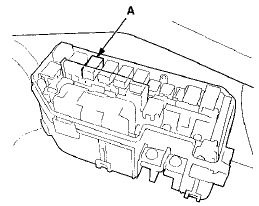
38. Check for continuity between body ground and PGM-FI main relay 1 4P connector terminals No. 1 and No. 4 individually.
PGM-FI MAIN RELAY 1 4P CONNECTOR
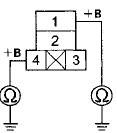
Terminal side of female terminals
Is there continuity? YES
-Replace the under-hood fuse/relay box (see page 22-85). Also replace the No. 17 Fl MAIN (15 A) fuse.
NO
-Go to step 39.
39. While disconnecting each of the parts or connectors below, one at a time, check for continuity between PGM-FI main relay 1 4P connector terminal No. 2 and body ground:
- PGM-FI main relay 2 (FUEL PUMP)
- ECM/PCM connector A (49P)
- Each injector 2P connector
- Camshaft position (CMP) sensor B 3P connector
- Crankshaft position (CKP) sensor 3P connector
- MAF sensor/IAT sensor 5P connector
- Electronic throttle control system (ETCS) control relay
PGM-FI MAIN RELAY 1 4P CONNECTOR

Terminal side of female terminals
Does continuity go away when one of the above parts or connectors is disconnected? YES
-Replace the part that made the short to body ground go away when disconnected. If the part is the ECM/PCM, update the ECM/PCM if it does not have the latest software (see page 11-203), or substitute a known-good ECM/PCM (see page 11-7), then recheck.
If the symptom/indication goes away and the ECM/PCM was updated, troubleshooting is complete.
If the symptom/indication goes away and the ECM/PCM was substituted, replace the original ECM/PCM (see page 11-204). Also replace the No. 17 Fl MAIN (15 A) fuse.
NO
-Go to step 40.
40. Disconnect the connectors from these components:
- PGM-FI main relay 2 (FUEL PUMP
- ECM/PCM connector A (49P)
- Injectors
- Camshaft position (CMP) sensor B
- MAF sensor/IAT sensor
- Crankshaft position (CKP) sensor
- Electronic throttle control system (ETCS) control relay
41. Check for continuity between PGM-FI main relay 1 4P connector terminal No. 2 and body ground.
PGM-FI MAIN RELAY 1 4P CONNECTOR

Terminal side of female terminals
Is there continuity? YES
-Repair short in the wire between PGM-FI main relay 1 and each part. Also replace the No. 17 Fl MAIN (15 A) fuse.
NO
-Replace PGM-FI main relay 1. Also replace the No. 17 Fl MAIN (15 A) fuse.
42. Inspect the No. 9 FUEL PUMP (20 A) fuse in the driver's under-dash fuse/relay box.
Is the fuse OK? YES
-Go to step 54.
NO
-Go to step 43.
43. Remove the blown No. 9 FUEL PUMP (20 A) fuse from the driver's under-dash fuse/relay box.
44. Remove PGM-FI main relay 2 (FUEL PUMP) (A) from the driver's under-dash fuse/relay box.
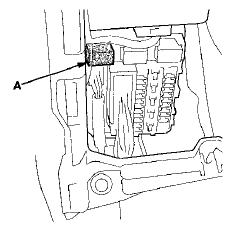
45 Test PGM-FI main relay 2 (FUEL PUMP) (see page 22-93).
Is the relay OK? YES
-Go to step 46.
NO
-Replace PGM-FI main relay 2 (FUEL PUMP). Also replace the No. 9 FUEL PUMP (20 A) fuse.
46. Check for continuity between PGM-FI main relay 2 (FUEL PUMP) 4P connector terminal No. 2 and body ground.
PGM-FI MAIN RELAY 2 (FUEL PUMP) 4P CONNECTOR

Terminal side of female terminals
Is there continuity? YES
-Go to step 47.
NO
-Go to step 50.
47. Jump the SCS line with the HDS.
48. Disconnect ECM/PCM connector C (49P).
49. Check for continuity between ECM/PCM connector terminal C10 and body ground.
ECM/PCM CONNECTOR C (49P)
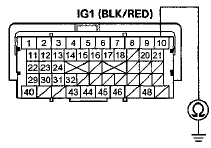
Terminal side of female terminals
Is there continuity?
YES-
Repair short in the wire between the No. 9 FUEL PUMP (20 A) fuse and the ECM/PCM (C10), between the No. 9 FUEL PUMP (20 A) fuse and PGM-FI main relay 2 (FUEL PUMP), or between the No. 9 FUEL PUMP (20 A) fuse and the immobilizer control unit.
Also replace the No. 9 FUEL PUMP (20 A) fuse
NO-
Replace the No. 9 FUEL PUMP (20 A) fuse, and update the ECM/PCM if it does not have the latest software (see page 11-203), or substitute a known-good ECM/PCM (see page 11-7), then recheck.
If the symptom/indication goes away and the ECM/PCM was updated, troubleshooting is complete.
If the symptom/indication goes away and the ECM/PCM was substituted, replace the original ECM/PCM (see page 11 -204).
50. Remove the rear seat cushion (see page 20-241).
51. Remove the access panel from the floor (see page 11-320).
52. Disconnect the fuel pump 4P connector.
53. Check for continuity between fuel pump 4P connector terminal No. 2 and body ground.
FUEL PUMP 4P CONNECTOR
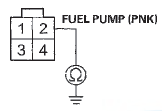
Wire side of female terminals
Is there continuity? YES
-Repair short in the wire between the fuel pump and PGM-FI main relay 2 (FUEL PUMP). Also replace the No. 9 FUEL PUMP (20 A) fuse.
NO
-Check the fuel pump, and replace it if necessary (see page 11-324). Also replace the No. 9 FUEL PUMP (20 A) fuse.
54. Jump the SCS line with the HDS.
55. Disconnect ECM/PCM connectors A (49P) and C (49P).
56. Turn the ignition switch to ON (II).
57. Measure the voltage between ECM/PCM connector terminal C10 and body ground.
ECM/PCM CONNECTOR C (49P)
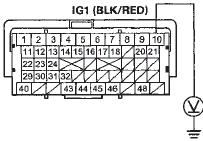
Terminal side of female terminals
Is there battery voltage? YES
-Go to step 58.
NO
-Repair open in the wire between the No. 9 FUEL PUMP (20 A) fuse and the ECM/PCM (C10).
58. Measure the voltage between ECM/PCM connector terminal A7 and body ground.
ECM/PCM CONNECTOR A (49P
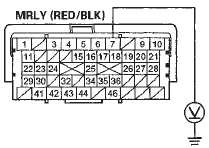
Terminal side of female terminals
Is there battery voltage? YES
-Go to step 63.
NO
-Go to step 59.
59. Turn the ignition switch to LOCK (0).
60. Remove PGM-FI main relay 1 (A) from the under-hood fuse/relay box.
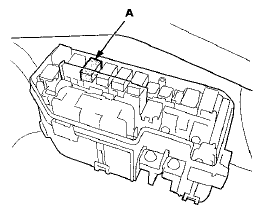
61. Measure the voltage-between PGM-FI main relay 1 4P connector terminal No. 4 and body ground.
PGM-FI MAIN RELAY 1 4P CONNECTOR

Terminal side of female terminals
Is there battery voltage? YES
-Go to step 62.
NO
-Replace the under-hood fuse/relay box (see page 22-85).
62. Check for continuity between PGM-FI main relay 1 4P connector terminal No. 3 and ECM/PCM connector terminal A7.
PGM-FI MAIN RELAY 1 4P CONNECTOR
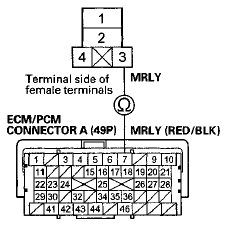
Terminal side of female terminals
Is there continuity?
YES
-Test PGM-FI main relay 1 (see page 22-93). If the relay is OK, update the ECM/PCM if it does not have the latest software (see page 11-203), or substitute a known-good ECM/PCM (see page 11-7), then recheck.
If the symptom/indication goes away and the ECM/PCM was updated, troubleshooting is complete.
If the symptom/indication goes away and the ECM/PCM was substituted, replace the original ECM/PCM (see page 11 -204).
NO-
Repair open in the wire between the ECM/PCM (A7) and PGM-FI main relay 1.
63. Turn the ignition switch to LOCK (0).
64. Remove PGM-FI main relay 1 (A) from the under-hood fuse/relay box.
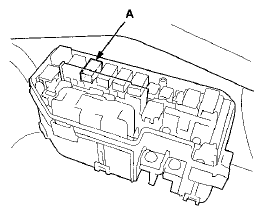
65. Measure the voltage between PGM-FI main relay 1 4P connector terminal No. 1 and body ground.
PGM-FI MAIN RELAY 1 4P CONNECTOR

Terminal side of female terminals
Is there battery voltage? YES-
Go to step 66.
NO
-Replace the under-hood fuse/relay box (see page 22-85).
66. Check for continuity between PGM-FI main relay 1 4P connector terminal No. 2 and ECM/PCM connector terminal A9.
PGM-FI MAIN RELAY 1 4P CONNECTOR
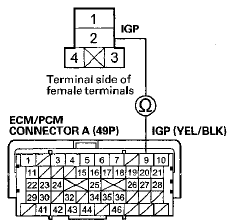
Terminal side of female terminals
Is there continuity? YES
-Go to step 67.
NO
-Repair open in the wire between the ECM/PCM (A9) and PGM-FI main relay 1.
67. Test PGM-FI main relay 1 (see page 22-93).
Is PGM-FI main relay 1 OK? YES
-Go to step 68.
NO-
Replace PGM-FI main relay 1.
68. Disconnect ECM/PCM connector B (49P).
69. Check for continuity between body ground and ECM/PCM connector terminals B1, B10, C2, C44, and C48 individually.
ECM/PCM CONNECTOR B (49P)
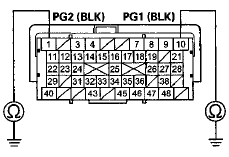
Terminal side of female terminals
ECM/PCM CONNECTOR C (49P)
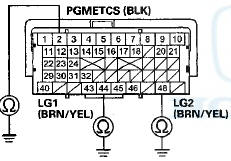
Terminal side of female terminals
Is there continuity? YES
-Go to step 70.
NO
-Repair open in the wire between the ECM/PCM (B1, B10, C2, C44, C48) and G101; M/T (see page 22-20), A/T (see page 22-22).
70. Check for continuity between ECM/PCM connector terminal C13 and body ground.
ECM/PCM CONNECTOR C (49P)
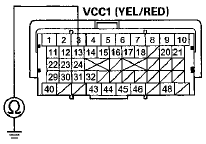
Terminal side of female terminals
Is there continuity? YES-
Go to step 71.
NO-
- A/T: Go to step 72.
- M/T: Go to step 74.
71. Continue to check for continuity between ECM/PCM connector terminal C13 and body ground, while disconnecting these connectors, one at a time:
- MAP sensor 3P connector
- Output shaft (countershaft) speed sensor 3P connector
Does continuity go away when one of the above connectors is disconnected? YES
-Replace the part that caused continuity to go away when it was disconnected.
NO-
Repair short in the wire between the ECM/PCM (C13) and the MAP sensor, or the output shaft (countershaft) speed sensor
72. Check for continuity between ECM/PCM connector terminal B19 and body ground.
ECM/PCM CONNECTOR B (49P)
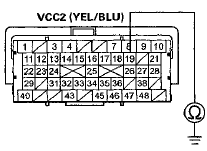
Terminal side of female terminals
Is there continuity? YES
-Go to step 73.
NO
-Go to step 74.
73. Continue to check for continuity between ECM/PCM connector terminal B19 and body ground while disconnecting the input shaft (mainshaft) speed sensor 3P connector.
Is there continuity? YES-
Repair short in the wire between the ECM/PCM (B19) and the input shaft (mainshaft) speed sensor.B NO
-Replace the input shaft (mainshaft) speed sensor (see page 14-187).
74. Check for continuity between ECM/PCM connector terminal C12 and body ground.
ECM/PCM CONNECTOR C (49P)
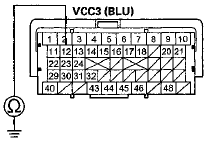
Terminal side of female terminals
Is there continuity? YES
-Go to step 75.
NO
-Go to step 76.
75. Continue to check for continuity between ECM/PCM connector terminal C12 and body ground while * disconnecting the throttle body 6P connector.
Is there continuity? YES
-Repair short in the wire between the ECM/PCM (C12) and the throttle body.
NO
-Replace the throttle body (see page 11-335).
76. Check for continuity between ECM/PCM connector terminal A26 and body ground.
ECM/PCM CONNECTOR A (49P)
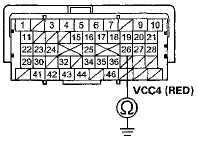
Terminal side of female terminals
Is there continuity? YES
-Go to step 77.
NO
-Go to step 78.
77. Continue to check for continuity between ECM/PCM connector terminal A26 and body ground while disconnecting the APP sensor 6P connector.
is there continuity? YES
-Repair short in the wire between the ECM/PCM (A26) and the APP sensor.
NO
-Replace the accelerator pedal module (see page 11-240).
78. Check for continuity between ECM/PCM connector terminal A25 and body ground.
ECM/PCM CONNECTOR A (49P)
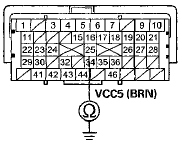
Terminal side of female terminals
Is there continuity?
YES-
Go to step 79.
NO
-Go to step 80.
79. Continue to check for continuity between ECM/PCM connector terminal A25 and body ground while disconnecting the APP sensor 6P connector.
Is there continuity? YES
-Repair short in the wire between the ECM/PCM (A25) and the APP sensor.
NO
-Replace the accelerator pedal module (see page 11-240).
80. Check for continuity between ECM/PCM connector terminal A20 and body ground.
ECM/PCM CONNECTOR A (49P)
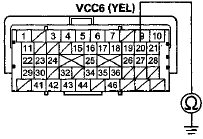
Terminal side of female terminals
Is there continuity? YES
-Go to step 81.
NO
-Update the ECM/PCM if it does not have the latest software (see page 11-203), or substitute a known-good ECM/PCM (see page 11-7), then recheck.
If the symptom/indication goes away and the ECM/PCM was updated, troubleshooting is complete.
If the symptom/indication goes away and the ECM/PCM was substituted, replace the original ECM/PCM (see page 11 -204).
81. Continue to check for continuity between ECM/PCM connector terminal A20 and body ground, while disconnecting these connectors, one at a time:
- FTP sensor 3P connector
- A/C pressure sensor 3P connector ('10 model)
Does continuity go away when one of the above connectors is disconnected? YES
-Replace the part that caused continuity to go away when it disconnected.
NO
-Repair short in the wire between the ECM/PCM (A20) and the FTP sensor, or the A/C pressure sensor ('IOmodel).
 MIL Circuit Troubleshooting
MIL Circuit Troubleshooting
1. Turn the ignition switch to ON (II).
2. Do the gauge self-diagnostic function (see page
22-332).
Does the MIL indicator flash?
YES-Go to step 3.
NO-Substitute a known-good gauge control ...
 Injector Replacement
Injector Replacement
1. Relieve the fuel pressure (see page 11-306).
2. Remove the engine cover,
3. Disconnect the quick-connect fitting (A).
4. Disconnect the Injector connectors (B) and the engine mount control
s ...
See also:
Subframe Replacement
Special Tools Required
Subframe Alignment Pin 070AG-SJAA10S
Front Subframe Torque
After removing the subframe mounting bolts, the front subframe middle rubber
mount mounting bolts, the front
sub ...
Symptom Troubleshooting
Index
...
Disc Scan
When you press the SCAN side of
the SCAN/A. SEL bar repeatedly
until you see D-SCAN in the center
display, or push the interface
selector to the right, the first track of
the current disc pl ...
